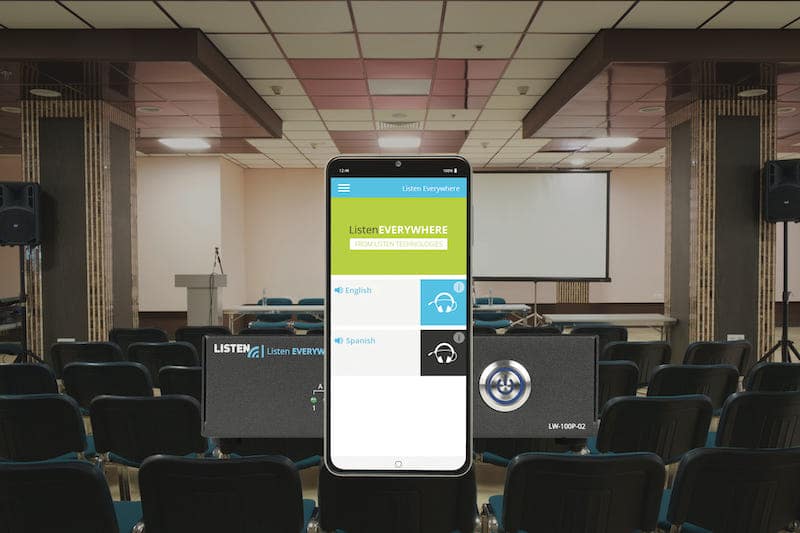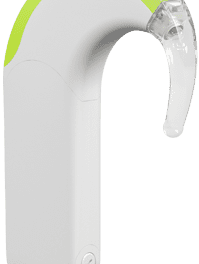Hearing care professionals play a critical role in educating young people about hearing health and the benefits of assistive listening systems.
By Kim Franklin
It’s time to sound the alarm on the impact of noise on children’s hearing. The CDC estimates 5.2 million young people between the ages 6 and 19 have damaged their hearing because of excessive exposure to noise.(1)
Audiologists and hearing device technicians play a crucial role in educating parents and young clients about the dangers of prolonged noise exposure and its impact on hearing health, as well as the long-term effects of hearing loss on overall health. They have the opportunity to positively impact clients by encouraging them (and their parents) to use ear protection, turn down the volume, and schedule annual visits to identify and address changes in hearing promptly. Additionally, hearing care professionals can help by educating young people about assistive listening systems—what they are, how they work, and when they might be useful.
Further reading: Educational Audiologists: Advocating for Children’s Learning Success
Assistive Listening Systems and Technologies
Under the Americans with Disabilities Act (ADA), venues must offer assistive listening systems in public assembly areas where audible communication is integral to the space. This means that most spaces where people gather, including classrooms, auditoria, and theaters, are required to have an assistive listening system. Clients may have seen signage depicting an ear with a line through it in public spaces such as movie theaters or museums. They need to know that this is a universal symbol indicating there is some sort of assistive listening system in the space, so they can make use of it.
They will also likely benefit from a straightforward explanation of how assistive listening systems help people hear clearly by delivering pure sound to the listener’s ear without amplifying ambient noise. They work by transmitting audio from the audio source, such as a microphone or TV, directly to a receiver. Depending on the type of assistive listening system, the receiver may be the listener’s hearing aid or cochlear implant, or a small portable unit connected to headphones, earbuds, or neck loop.
There are different types of assistive listening systems that utilize different technologies. Pediatric audiology clients of all ages may benefit from an initial explanation or refresher of the options currently available to them and how they could help them in different situations.
• In radio frequency (RF) assistive listening systems, venue audio sources are connected to transmitters that send radio frequency signals to an antenna. The antenna transmits the signal over radio frequency to individual receivers. The receivers are tuned to the radio frequency channel to receive the audio. The receivers typically are small, lightweight units that venues offer guests for use while they are in a space. Guests wear the receivers on a lanyard around their neck and listen to audio through headphones or earbuds connected to the unit. For guests with hearing aids or cochlear implants featuring telecoils, portable neck loops are available to connect to the receiver and transmit audio directly to the telecoil-enabled hearing device. RF-based systems are ideal in auditoria, stadiums, and other large spaces.
• Infrared assistive listening systems work similarly to remote control devices. Sound is broadcast from an assistive listening transmitter to receivers via infrared light. Receivers (also small, portable units like those used with radio frequency systems) must be within line of sight of the transmitter’s infrared light to receive the audio. Listeners hear clear sound through headphones or earbuds connected to the receiver, or, if they have telecoil-enabled hearing aids or cochlear implants, directly through those devices via a portable neck loop connected to the receiver. With infrared systems, there is no audio spill-over into adjacent rooms, as can happen with radio frequency. This makes infrared-based systems especially useful in schools where there are multiple adjoining classrooms and in places where confidentiality is important, such as in company board rooms, medical offices, or courtrooms.
• A portable assistive listening system featuring transceivers (units that are both a transmitter and receiver) can be used for assistive listening and two-way communication. With this type of system, a presenter wears a transceiver and headset with a mic and the listener can use either a transceiver or a receiver to hear the audio. Presenters can invite listeners to respond by speaking into the transceiver while pressing a button. This type of system is useful for field trips and tours, to provide coaching and theatrical direction, to facilitate simultaneous interpretation, and, as a boarding school in Denmark demonstrated, for assistive listening and two-way communication in classrooms.
• Audio over Wi-Fi assistive listening systems let listeners use their personal smartphone or smart device as a receiver. A venue’s sound source is connected to a server and live or recorded audio streams over the venue’s existing wireless network. Listeners download a free app on their smartphone, select the channel with their preferred audio, and listen via headphones or earbuds connected to their device. If listeners wear Bluetooth-enabled hearing aids or cochlear implants, they can stream sound from their smartphone directly to their Bluetooth-enabled devices.
• Hearing Loop technology utilizes electromagnetic fields to transmit the audio signal directly to hearing aids and cochlear implants equipped with telecoils. This ensures that users can enjoy a seamless and immersive listening experience without the distractions of background noise or interference. Hearing loops are compatible with a wide range of venues including theaters, places of worship, conference rooms, and public transportation.
Another upcoming audio technology that is garnering a lot of attention is Auracast, which utilizes Bluetooth low energy (LE). Although each manufacturer will release different products to market, they will function similarly to an existing system, meaning there will be an audio source (live presenter, TV audio, recorded audio, etc.), an Auracast-enabled transmitter to broadcast the audio, and a receiver to receive the audio. Note, guests will have the option to use their smartphone as a receiver, if it has the capability for Bluetooth LE, which is not the same as the classic Bluetooth most people are familiar with. Auracast-based products for assistive listening applications are expected to hit the consumer and pro audio market in 2024-2025.

With audio over Wi-Fi, students can download and use a free app like Listen Everywhere on their smartphone, select the channel featuring their preferred audio, and stream the audio from their device to their Bluetooth-enabled hearing aids or cochlear implants. Photo: Listen Everywhere
Easy and Inconspicuous Access
While each type of assistive listening technology and system can benefit young people, audio over Wi-Fi assistive listening systems are especially suited to this demographic and the educational environments where they spend much of their time.
School and campus settings can be challenging listening situations. Distance from a speaker or audio source in a large, crowded lecture hall, classroom, or auditorium; background noise; poor acoustics; hearing loss; an instructor who moves about or has her back to students so it is difficult to read lips or interpret facial expressions—any of these can make it difficult for students to hear audio clearly and understand.
One of the many benefits of audio over Wi-Fi technology is that it lets listeners use personal smart devices they already have access to and use regularly as assistive listening receivers.(2) This ubiquity of devices increases the likelihood young people will use their smartphone or smart device (BYOD—bring your own device) for assistive listening if their school has an audio over Wi-Fi assistive listening system for a couple of key reasons.
- It helps reduce self-consciousness they may feel about utilizing assistive technology since others would not know they are using their device for assistive listening. They could be listening to music or a podcast or simply blocking out background noise.
- Because listeners use their own smartphones and smart devices as receivers, they do not need to borrow assistive listening equipment from their school, which might involve scheduling an appointment with a counselor or AV coordinator and visiting a resources office where devices are stored. With audio over Wi-Fi, students don’t need to check out, keep track of, charge, remember to bring to class, or return a borrowed device. Instead, they open the app on their smartphone, select the channel featuring their preferred audio (i.e., Mrs. Jones’ classroom, Lab Room 2), adjust the volume, and listen to audio through earbuds or headphones connected to their device. Background noise is filtered out. Alternatively, they can stream the audio from their device to their Bluetooth-enabled hearing aids or cochlear implants.
If a young person does not have a smartphone and would like to borrow a dedicated smartphone receiver from a school for use, they likely will find the receiver easy to use because it will utilize intuitive, familiar technology.
Further reading: ASHA Urges Families to Identify Signs of Hearing Loss for Children
Beyond Assistive Listening
With audio over Wi-Fi, educators and administrators can provide additional information to students via the app. This might look like class syllabi, study guides, links to additional resources, and promotions for school events. Audio channels can also be designated for different languages if interpretation is provided. Because the system extends as far as the school’s Wi-Fi network, audio is not just limited to the classroom. Students can continue to hear audio if they need to step outside the classroom or if groups of students are spread across multiple spaces.
Audio over Wi-Fi systems can be used for audio description in a theater/drama setting at a school (unique applications could include playing pre-recorded audio of the school’s messages, announcements, lessons, history, etc.) and to provide audio from silent screens in fitness centers, student unions, and dining spaces.
Audio over Wi-Fi can be used in school theaters as well – to deliver clear audio to audience members and to performers. For example, an audio over Wi-Fi assistive listening system helped a high school senior with a cochlear implant participate more fully in a musical theater production at his school. He downloaded the assistive listening app on his smartphone to access audio from the show director’s and main characters’ mics. He carried his smartphone in a chest pocket on a T-shirt he wore under his costume. A neck loop under his costume plugged into his smartphone transmitted audio to his cochlear implant, making it possible to hear his stage cues in a way he hadn’t been able to do before, and helping the student hear well enough to perform multiple parts and be fully engaged in the production.
Advocating for Access
Assistive listening systems can benefit all children and teens whether they have diagnosed hearing loss, find it challenging to hear in certain situations, or just want to filter out ambient noise to focus on the speaker or primary audio source. Assistive listening systems are required in classrooms and education environments under the ADA. Audiologists can help their young clients benefit from assistive listening systems by educating them about how they work and encouraging them to ask for and use assistive listening devices in school and other public spaces where they are available.
About the author: Kim Franklin is vice president of global marketing at Listen Technologies, a provider of advanced wireless listening solutions for 25 years.
Featured image: Assistive listening systems can benefit all children and teens whether they have diagnosed hearing loss, find it challenging to hear in class or other situations, or just want to filter out ambient noise to focus on the speaker or primary audio source. Photo: iStock.
References:
- US Centers for Disease Control. Hearing Loss in Children: Preventing Noise-Induced Hearing Loss. Aug. 4, 2023. Available at: https://www.cdc.gov/ncbddd/hearingloss/noise.html#:~:text=An%20 estimated%2012.5%25%20of%20children,from%20excessive%20exposure%20to%20noise
- Vogels EA, Gelles-Watnick R, and Massarat N. Teens, Social Media and Technology 2022. 2022. Available at: https://www.pewresearch.org/internet/2022/08/10/teens-social-media-and-technology-2022/





